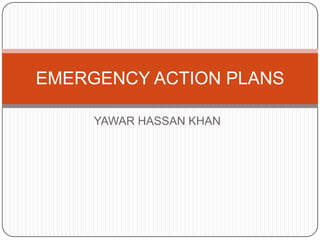Emergency action plans
- 1. EMERGENCY ACTION PLANS YAWAR HASSAN KHAN
- 2. WHAT IS AN EMERGENCY ACTION PLAN ï An action plan to organize employee and employer action during workplace emergencies
- 3. COMPONENTS OF AN EFFECTIVE EMERGENCY ACTION PLAN ï Ways to report fires and other emergencies ï Evacuation procedures ï Emergency escape route assignments ï Procedures to account for all employee after an emergency evacuation has been completed ï Name or job titles of personas who can be contacted for further information or explanation of duties under the plan.
- 4. NATURAL DISASTERS ï Avalanche ï Biological ï Drought ï Sand storms ï Earth quakes ï Extreme heat / cold ï Fire ï Flood ï Hurricane ï Landslide / Madslide ï Lightning ï Snow / Ice / hail ï Tornando ï Volcanic eruption ï Tsunami
- 5. TECHNOLOGICAL EMERGENCIES ï Aircraft crash ï Structural collapse ï Business interruption ï Communication ï Levee failure ï Explosion/fire ï Extreme air pollution ï Financial collapse ï Fuel .resource shortage ï Hazardous material release ï Power / utility failure ï Radiological / nuclear accidents ï Transportation accidents
- 6. WHAT ARE THE STEPS IN DEVELOPING EAP ï Development of emergency action plan ï Establish authority ï Conduct employee training and plan review ï Review , coordinate and update the plan
- 7. ï Make sure EAP meets specific needs
- 8. ï Consider and list potential natural or man made emergencies
- 9. ï Develop resue and medical assistance strategies
- 11. ï Identify methods for reporting fires
- 12. ï Develop methods to alert employees
- 13. ï Identify methods to alert employees
- 14. ï Identify how and when the employees will be trained
- 15. ï Address how and when drills and retraining will be conducted
- 16. ï One policy doesnât fit all situations
- 17. ï Designate someone who will stay to shut down critical operations during an evacuation
- 18. ï Determine specific evacuation routes and exits
- 19. ï Designate evacuation coordinates and workdens
- 20. ï Conduct EAP employee training
- 21. ï Update the EAP regularly
- 22. THANK YOU ï Please give your feedback :yawarhkhan@hotmail.com






















